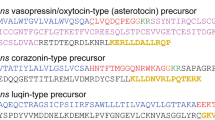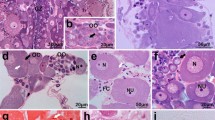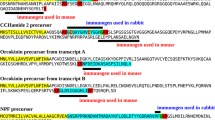Abstract
The atrial gland is an exocrine organ that secretes into the oviduct of Aplysia californica and expresses three homologous genes belonging to the egglaying hormone gene family. Although post-translational processing of the egg-laying hormone precursor in the neuroendocrine bag cells has been examined in detail, relatively little is known about the post-translational processing of egg-laying hormone-related gene products in the atrial gland. A combination of morphologic techniques that included light-microscopic histology and immunocytochemistry, transmission electron microscopy, and immuno-electron microscopy were used to localize egg-laying hormone-related peptides in the atrial gland and to evaluate the characteristic morphology of their secretory cells. Results of these studies showed that there were at least three major types of secretory cells in the atrial gland (types 1–3). Significantly, of these three cell types, only type 1 was immunoreactive to antisera against egg-laying hormone-related precursor peptides. The immunoreactivity studies established that all three egg-laying hormone-related precursor genes are expressed in type-1 cells and indicated that the processing of these precursors also occurs within the secretory granules of this cell type. Evidence was also obtained that proteolytic processing of the egg-laying hormone-related precursors differed significantly from that observed in the bag cells. In contrast to the bag cells, the NH2-terminal and COOH-terminal products of the egg-laying hormone-related precursors of the atrial gland were not sorted into different types of vesicles.
Similar content being viewed by others
References
Arch S, Lupatkin J, Smock T, Beard M (1980) Evidence for an exocrine function of the Aplysia atrial gland. J Comp Physiol 141:131–137
Avrameas S, Ternynck T (1969) The cross-linking of proteins with glutaraldehyde and its use for the preparation of immunoadsorbents. Immunochemistry 6:53–66
Beard M, Millecchia L, Masuoka C, Arch S (1982) Ultrastructure of secretion in the atrial gland of a mollusc (Aplysia). Tissue Cell 14:297–308
Heller E, Kaczmarek LK, Hunkapiller MW, Hood LE, Strumwasser F (1980) Purification and primary structure of two neuroactive peptides that cause bag cell afterdischarge and egg-laying in Aplysia. Proc Natl Acad Sci USA 77:2328–2332
Heumen WRA van, Roubos EW (1991) Immuno-electron microscopy of sorting and release of neuropeptides by Lymnaea stagnalis. Cell Tissue Res 264:185–195
Kreiner T, Sossin W, Scheller RH (1986) Localization of Aplysia neurosecretory peptides to multiple populations of dense core vesicles. J Cell Biol 102:769–782
Li KW, Geraerts WPM, Elk R van, Joosse J (1989) Dot immunobinding assay of high performance liquid chromatographic fractions on poly(vinylidene difluoride) membrane. J Chromatogr 472:445–446
Mahon AC, Nambu JR, Taussig R, Shyamala M, Roach A, Scheller RH (1985) Structure and expression of the egg-laying hormone gene family in Aplysia. J Neurosci 5:1872–1880
Minnen J van, Haar C van der, Raap AK, Vreugdenhil E (1988) Localization of ovulation hormone-like neuropeptide in the central nervous system of the snail Lymnaea stagnalis by means of immunocytochemistry and in situ hybridization. Cell Tissue Res 251:477–484
Nagle GT, Painter SD, Blankenship JE, Dixon JD, Kurosky A (1986) Evidence for the expression of three genes encoding homologous atrial gland peptides that cause egg laying in Aplysia. J Biol Chem 261:7853–7859
Nagle GT, Painter SD, Blankenship JE, Kurosky A (1988) Proteolytic processing of egg-laying hormone-related precursors in Aplysia. J Biol Chem 263:9223–9237
Nagle GT, Heumen WRA van, Knock SL, Garcia AT, McCullough DA, Kurosky A (1993a) Occurrence of a furin-like pro-hormone processing enzyme in Aplysia neuroendocrine bag cells. Comp Biochem Physiol [B] 105: 345–348
Nagle GT, Knock SL, Heumen WRA van, Garcia AT, Gorham E (1993b) Isolation and molecular cloning of Aplysia furin and PC2, two candidate prohormone processing enzymes (abstract). Soc Neurosci Abstr 19:1360
Nagle GT, Heumen WRA van, El-Hamzawy MA, Kurosky A (1994) Purification and characterization of Aplysia atrial gland secretory granules containing egg-laying prohormone-related peptides. Peptides 15:101–108
Orci L, Ravazzola M, Amherdt M, Madsen O, Vassalli J-D, Perrelet A (1985) Direct identification of prohormone conversion site in insulin-secreting cells. Cell 42:671–681
Painter SD, Kalman VK, Nagle GT, Zuckerman RA, Blankenship JE (1985) The anatomy and functional morphology of the large hermaphroditic duct of three species of Aplysia, with special reference to the atrial gland. J Morphol 186:167–194
Rothman BS, Hawke DH, Brown RO, Lee TD, Dehghan AA, Shively LE, Mayeri E (1986) Isolation and primary structure of the califins, three biologically active egg-laying hormone-like peptides from the atrial gland of Aplysia californica. J Biol Chem 261:1616–1623
Roubos EW, Wal-Divendal RM van der (1980) Ultrastructural analysis of peptide-hormone release by exocytosis. Cell Tissue Res 207:267–275
Scheller RH, Jackson JF, McAllister LB, Rothman BS, Mayeri E, Axel R (1983) A single gene encodes multiple neuropeptides mediating a stereotyped behavior. Cell 32:7–22
Sossin WS, Kreiner T, Barinaga M, Schilling J, Scheller RH (1989) A dense core vesicle protein is restricted to the cortex of granules in the exocrine atrial gland of Aplysia californica. J Biol Chem 264:16933–16940
Sossin WS, Fisher JM, Scheller RH (1990a) Sorting within the regulated secretory pathway occurs in the trans-Golgi network. J Cell Biol 110:1–12
Sossin WS, Sweet-Cordero A, Scheller RH (1990b) Dale's hypothesis revisited: different neuropeptides derived from a common prohormone are targeted to different processes. Proc Natl Acad Sci USA 87:4845–4848
Steiner DF, Smeekens SP, Ohagi S, Chan SJ (1992) The new enzymology of precursor processing endoproteases. J Biol Chem 267:23435–23438
Author information
Authors and Affiliations
Rights and permissions
About this article
Cite this article
van Heumen, W.R.A., Nagle, G.T. & Kurosky, A. Ultrastructural localization of egg-laying prohormone-related peptides in the atrial gland of Aplysia californica . Cell Tissue Res 279, 13–24 (1995). https://doi.org/10.1007/BF00300687
Received:
Accepted:
Issue Date:
DOI: https://doi.org/10.1007/BF00300687




